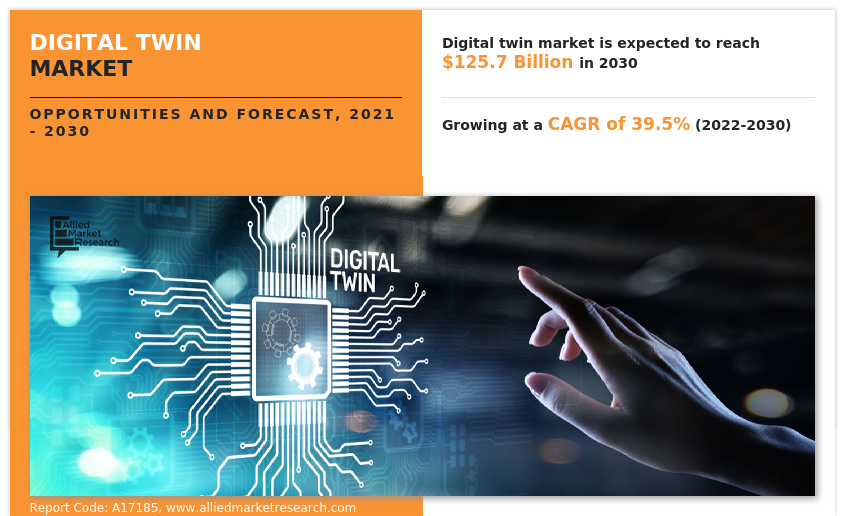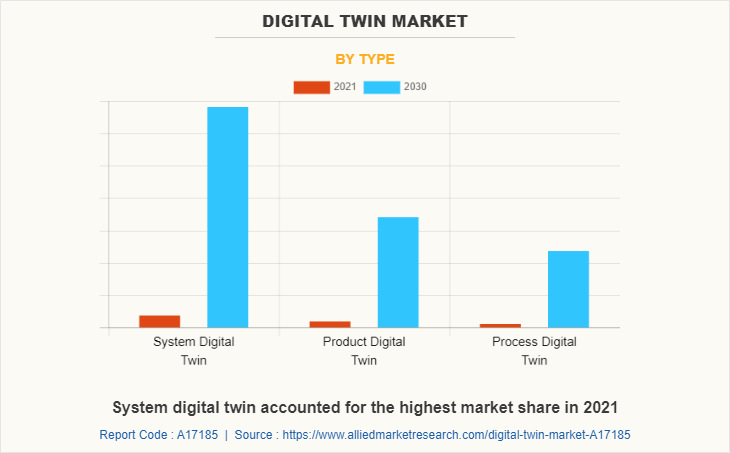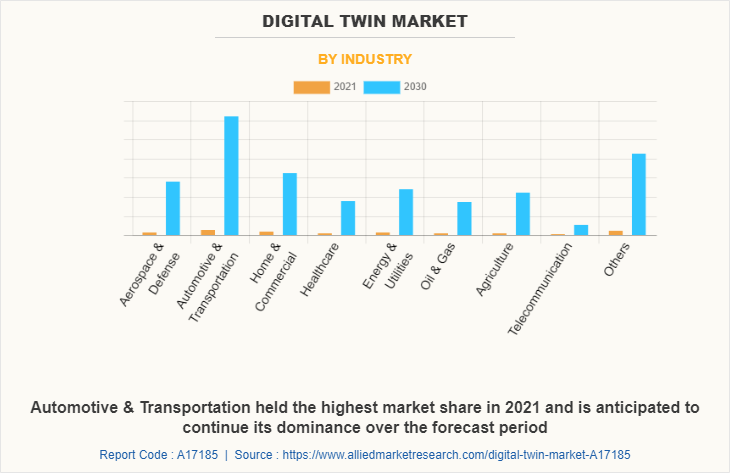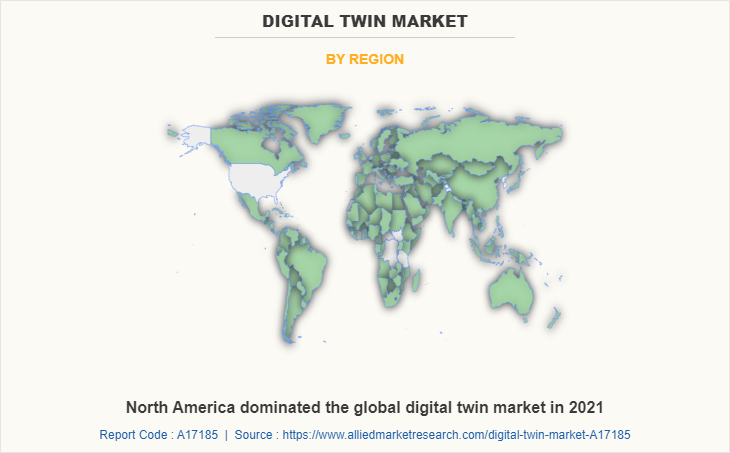Digital Twin Market Research, 2030
The Global Digital Twin Market was valued at $6.5 billion in 2021 and is projected to reach $125.7 billion by 2030, growing at a CAGR of 39.48% from 2021 to 2030.
A digital twin is a dynamic representation of a virtual machine that provides a real-time online equivalent of a physical object or process. It profiles, predicts, and optimizes the performance of industrial assets using simulation models and data intelligence. Digital twin is an important component of the Industrial Internet of Things because it enables automatic vehicle control and monitoring of industrial assets and processes such as product development, design & manufacturing planning, investment performance management, business & operation optimization, and others.

Digital technologies like the cloud, big data, IoT, and artificial intelligence are increasingly being implemented in different areas of business. The creation of a digital twin entails the virtualization of the physical twin using a variety of IoT sensors and digital technologies. The benefits of using digital twin technology are well known, even though it is still in its infancy. With further research and development, the systems might soon play a significant role in many current robotics systems.
The aerospace industry as well as other industries employ digital twin technology in several applications. Due to its extremely high level of dependability and accuracy, the digital twin technology is particularly helpful in the robotics industry. Military, aeronautical, biomedical, automotive, and maritime applications are among other fields where digital twin technology is widely used.
With growing connectivity, the risk of data protection, cyber-attacks, and compliance has also increased. This is one of the prominent factors impeding digital twin market growth. Also, the risk of misrepresenting the system or object they wish to copy with the help of this technology is the main worry shared by most business owners who are interested in digital twin technology. Since there isn't any reliable proof of how exact the digital twin technology is in comparison to its physical counterpart, many businesses refrain from using the technology.
The combination of digital twin technology with IoT, machine learning, and cloud computing is expected to accelerate digital twin market growth even further. Companies are deploying Internet of Things and artificial intelligence (AI) technologies to collect and process behavioral data from IoT devices and connected products, which can then be applied to the digital twin model to replicate the performance and usage of the existing device.
Some of the leading digital twin market players are ABB Group, ANSYS Inc., Accenture plc, Autodesk Inc, Bentley Systems, AVEVA Inc., bosch rexroth ag, Oracle Corporation, Siemens AG, Rockwell Automation Inc., and Schneider Electric.
The global digital twin market is segmented based on type which has been divided into system digital twin, product digital twin, and process digital twin. By industry, the market has been divided into aerospace & defense, automotive & transportation, home & commercial, healthcare, energy & utilities, oil & gas, agriculture, telecommunication, and others. By region, the market is analyzed across North America, Europe, Asia-Pacific, and LAMEA.
Key Takeaways
- The global digital twinmarket study covers 20 countries. The research includes a segment analysis of each country in terms of value for the projected period.
- More than 1,500 product literature, industry releases, annual reports, and other such documents of major market industry participants along with authentic industry journals, trade associations' releases, and government websites have been reviewed for generating high-value industry insights.
- The study integrated high-quality data, professional opinions and analysis, and critical independent perspectives. The research approach is intended to provide a balanced view of global markets and to assist stakeholders in making educated decisions to achieve their most ambitious growth objectives.
Digital Twin Market Segment Overview
The digital twin market is segmented into Type and Industry.
By type, the system digital twin sub-segment is expected to have the dominant share during the forecast period. This dominance is primarily due to the widespread use of system digital twins by several industries, including automotive, manufacturing, oil & gas, energy & utilities, and others, to identify new revenue-generating opportunities through cost reduction and customer service enhancement. These are predicted to be the major factors affecting the digital twin market size during the forecast period too.

By industry, the automotive & transportation industries had the largest digital twin market share in 2021 and are expected to grow by 2030. This dominance in the overall digital twin market is largely due to the widespread use of digital twin technologies in the automotive & transportation sectors for creating digital models of connected vehicles.

By region, the Asia-Pacific market is forecasted to be the fastest-growing region market during the forecast period. There is an increasing demand for digital twins in several industries, including automotive, manufacturing, and other verticals, to reduce labor costs. The emergence of different software as well as the deployment of automation solutions in manufacturing companies has improved manufacturing lines and downstream operations in recent years. Because of the strong economic growth and the large presence of vendors offering digital twins, these advancements have positively affected the growth of the digital twin market in the Asian region. Furthermore, increased R&D inside the IoT and intelligent systems fields, as well as increased demand for effective and expensive technologies for the production process, is supporting regional market growth.

Key Market Dynamics
The digital twin market is driven by advancements in IoT, AI, and cloud technologies, enabling real-time simulation and predictive maintenance across industries such as manufacturing, healthcare, and automotive. Its ability to optimize operational efficiency and reduce downtime is a key growth factor.
However, high implementation costs, data security concerns, and the complexity of integration with legacy systems restraining the growth of the digital twin market.
Despite challenges, there are abundant opportunities to expand applications in smart cities, energy, and the metaverse, supported by 5G and edge computing. Despite restraints like interoperability and regulatory hurdles, the market holds strong potential for innovation and adoption across diverse sectors.
Regional/Country Market Outlook
The global digital twin market share is experiencing substantial growth, with Asia-Pacific playing a pivotal role in this expansion. Asia-Pacific leads the market, propelled by rapid industrialization, urbanization, and strong adoption of smart technologies. Countries like China, Japan, and South Korea are investing heavily in IoT, AI, and Industry 4.0 initiatives. The region's growing demand for automation in manufacturing and smart city projects further boosts market growth. This leadership positions Asia-Pacific for continued innovation and success—exciting times ahead! Keep exploring this dynamic market Emerging economies like China and India drive significant growth, supported by government initiatives for digital infrastructure development. In North America, the digital twin market is rising due to increased investments in advanced technologies, such as IoT and AI, alongside a focus on improving operational efficiency in industries like manufacturing, aerospace, and healthcare. The region's strong innovation ecosystem and skilled workforce further enhance market growth prospects.
Report Coverage & Deliverables
This report delivers in-depth insights into the digital twin market covering offering, type, and industry key strategies employed by major players. It offers detailed market forecasts and emerging trends.
Type Insights
System Digital Twins replicate entire systems for performance optimization, often used in smart cities and large infrastructure projects. Product Digital Twins focuses on individual products throughout their lifecycle, enhancing design and development. Process Digital Twins model business processes to improve efficiency and decision-making, playing a crucial role in manufacturing and supply chain management.
Industry Insights
Aerospace & Defense uses digital twins for aircraft design and maintenance optimization. The Automotive & Transportation sectors enhance vehicle performance and safety. Home & Commercial applications focus on smart building management. Healthcare benefits from patient monitoring and treatment optimization. Energy & Utilities utilize digital twins for grid management and efficiency. Oil & Gas companies apply the technology for asset monitoring and risk management. Agriculture employs digital twins for precision farming, while Telecommunication enhances network optimization. Together, these industries drive significant growth and innovation in the digital twin market.
Regional Insights
North America dominates the digital twin market, fueled by technological advancements and strong investment in R&D. Europe follows, with significant growth driven by initiatives in smart manufacturing and sustainability. The Asia-Pacific region is rapidly emerging, supported by industrialization and urbanization, particularly in countries like China and India. Latin America and the Middle East are gradually adopting digital twin technology, focusing on infrastructure and resource management. Overall, regional dynamics highlight varying levels of adoption and innovation across the globe.
Key Strategies and Developments
- In May 2022, AVEVA Inc. launched an enhanced digital twin solution that integrates wearable scanning and robust document control. This solution allows for faster time to value for both greenfield and brownfield projects, enabling the creation of a complete digital twin within just 60 days, even without existing models., Siemon launched advanced optical patching solutions for generative AI networks, which can benefit from digital twin patch panels. This highlights the ongoing innovation in the field to support complex network infrastructures.
- In April 2024, In a strategic partnership with Mercedes-Benz AG, Siemens co-created a Digital Energy Twin. This tool improves the integration of energy efficiency and sustainability measures in factory designs and upgrades, significantly reducing early-phase planning time.
Key Benefits For Stakeholders
- This report provides a quantitative analysis of the market segments, current trends, estimations, and dynamics of the digital twin market analysis from 2021 to 2030 to identify the prevailing digital twin market forecast.
- The market research is offered along with information related to key drivers, restraints, and digital twin market opportunities.
- Porter's five forces analysis highlights the potency of buyers and suppliers to enable stakeholders to make profit-oriented business decisions and strengthen their supplier-buyer network.
- An in-depth analysis of the digital twin market segmentation assists in determining the prevailing market opportunities.
- Major countries in each region are mapped according to their revenue contribution to the global digital twin market outlook.
- Market player positioning facilitates benchmarking and provides a clear understanding of the present position of the digital twin market trends that are being followed by the players.
- The report includes an analysis of the regional as well as global digital twin market outlook, key players, market segments, application areas, and market growth strategies.
Digital Twin Market Report Highlights
| Aspects | Details |
| Market Size By 2030 | USD 125.7 billion |
| Growth Rate | CAGR of 39.5% |
| Forecast period | 2021 - 2030 |
| Report Pages | 260 |
| By Type |
|
| By Industry |
|
| By Region |
|
| Key Market Players | ANSYS Inc., Accenture plc, Oracle Corporation, Rockwell Automation Inc., Siemens AG, Autodesk Inc, bosch rexroth ag, ABB Group, AVEVA Inc., bentley systems, Schneider Electric |
Analyst Review
The digital twin is a digital representation of both non-living and living physical objects such as things, people, and processes. It is used to investigate operations and gain knowledge of critical processes. Because of these benefits, end-use industries are increasing their demand for digital twins, which is a major driving factor for market growth during the forecast period.
Due to accuracy issues and doubt in the authenticity of results produced by digital twin technology, the market is expected to observe a negative growth in the forecast time period.
However, companies in these industry verticals are constantly utilizing digital twin systems and technologies to estimate the performance of physical assets and identify where the modifications are needed. Such factors are expected to increase the demand for innovative solutions such as digital twin.
According to the analysts, Asia-Pacific is projected to register faster growth as compared to North American and European markets.
The Digital Twin Market was valued at $6.5 billion in 2021 and is projected to reach $125.7 billion by 2030, growing at a CAGR of 39.48% from 2021 to 2030.
The Digital Twin Market encompasses the industry focused on creating virtual replicas of physical objects or processes, enabling real-time monitoring, simulation, and optimization across various sectors.
Leading companies in the Digital Twin Market include ABB Group, ANSYS Inc., Accenture plc, Autodesk Inc., Bentley Systems, AVEVA Inc., Bosch Rexroth AG, Oracle Corporation, Siemens AG, Rockwell Automation Inc., and Schneider Electric.
As of the latest data, North America holds the largest share in the Digital Twin Market, driven by rapid technological adoption and significant investments in digital solutions.
Key drivers include the increasing adoption of IoT and cloud-based solutions, the need for real-time data analytics, and the demand for predictive maintenance to reduce operational costs.
Challenges include concerns over data security and privacy, high implementation costs, and the complexity of integrating digital twin solutions with existing systems.
Loading Table Of Content...


